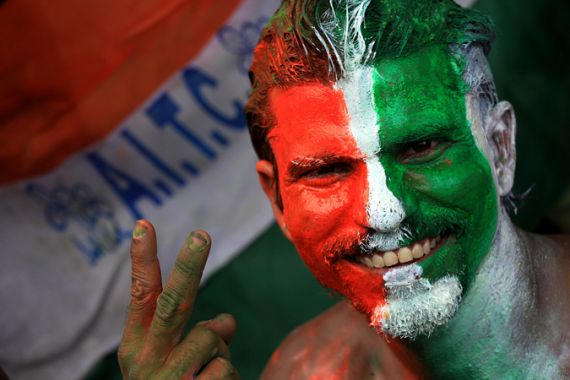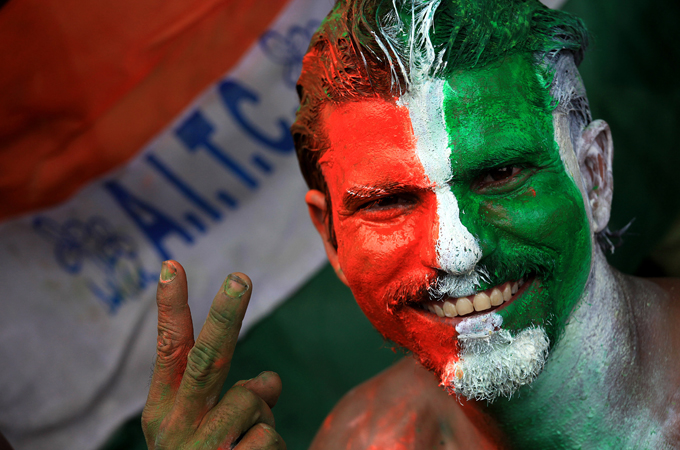The end of an era in West Bengal and India
The three-decade rule of the communist party in West Bengal has tasted the bitterness of defeat for the first time.

 |
| The Trinamool Congress celebrated a historic victory in West Bengal as they finally unseated a three-decade monopoly of politics in India’s fourth most populous state [EPA] |
The world’s longest-serving elected communist government has come to an end in eastern India.
The Left Front (LF), a coalition dominated by by India’s largest parliamentary communist party, the Communist Party of India (Marxist), or CPI(M), had governed West Bengal, India’s fourth most populous state – population 91 million, electorate 56 million – uninterruptedly since 1977.
During these 34 years, the LF won seven consecutive state elections in West Bengal, an unparalleled feat in India’s democratic history. Throughout, the LF never won fewer than two-thirds of the 294 seats in West Bengal’s legislative assembly (the state’s parliament), and its dominant party, CPI(M), invariably won a simple majority of the seats on its own.
With a vengeance
If the longevity of LF rule in West Bengal is without parallel in independent India, the end too has been startlingly ignominious. In just-concluded state elections, West Bengal’s people have voted the LF and the CPI(M) out of power with a vengeance.
From 235 seats in the previous assembly, elected in 2006, the LF tally has fallen to 61 seats. The CPI(M), which won between 170 and 190 seats in most elections since 1977 and strode the state’s politics like a colossus, has been reduced to just 40 seats. The vast majority of the CPI(M)’s leading figures, including the state’s chief minister, have lost in their constituencies.
The big winner is the Trinamool (‘Grassroots’) Congress, a “regional” (that is, West Bengal-specific) party formed in 1998 as a breakaway from the state’s Congress party, which was until then the main opposition to the LF. Trinamool Congress has won 184 seats, a resounding majority. Its parent party, the Congress, now reduced to a junior ally of its splinter, has won 42 seats, and the new government in West Bengal commands a three-fourths majority in the state’s legislature.
Trinamool Congress is an important example of the “regional” or state-specific parties that have come to dominate the politics of many of India’s states over the past two decades, as Congress has declined and the other “national” party, the Hindu nationalist Bharatiya Janata Party (BJP), has failed to realise its ambition of emerging as the new fulcrum of India’s democracy.
The regional parties also determine who governs at the political centre, New Delhi. Since 1996, in a sharp departure from the previous tradition of single-party Congress governments at the centre, India has been governed by polyglot coalitions. From 1998 to 2004 the ruling coalition was led by BJP and since then by Congress. Both parties have depended on regional allies to cobble together parliamentary majorities.
West Bengal’s Trinamool Congress is synonymous with the powerful personality of its founder and supreme leader, a 56 year-old woman called Mamata Banerjee. Of humble social origins – she was born and raised in a slum district of Calcutta, where she still lives – Banerjee is a charismatic populist par excellence. She represents a genre of politicians who increasingly define the shape of India’s politics – a leader with a formidable mass base in one large state of the 28 states of widely varying populations that comprise the Indian Union.
Some of the other exemplars of this genre are also women. Mayawati, who is about the same age as Banerjee and like her has been active in politics since the early 1980s, heads the government of Uttar Pradesh (‘Northern Province’), India’s most populous state, a vast sprawl across the Indo-Gangetic plain of northern India. Mayawati belongs to the Dalit (literally, ‘oppressed’) community, a label for the formerly “untouchable” castes.
Another exemplar is Jayalalitha of the deep-south State of Tamil Nadu. A one-time star of Tamil cinema, Jayalalitha too has been a politician since the 1980s. She has just led her party to a massive electoral victory in Tamil Nadu and is poised to take over – though unlike Banerjee, not for the first time – as that large state’s chief minister.
Hegemonic rule
Like all hegemonic regimes, the extraordinary longevity of LF and particularly CPI(M) primacy in West Bengal was built on a complex dialectic of coercion and consent – to borrow from the framework of the Italian communist Antonio Gramsci.
LF and CPI(M) hegemony in West Bengal was rooted in the turn of a sizeable element of the Bengali intelligentsia to communist and socialist ideas after India’s independence. The mass base came primarily from strong party organisations developed among the peasantry, particularly poorer peasants.
The Left Front usually won just under half the popular vote during its three decades in power, a proportion magnified into commanding legislative majorities by the ‘first-past-the-post’ system. But it had majority support among the poorer sections of society, including Muslims (over a quarter of the electorate) and low-caste and tribal communities. The ‘pro-poor’ image was the LF’s greatest asset.
The problem was that the image and rhetoric did not translate into policies that substantially improved the lot of the poor over time. After implementing a modest land reform programme during its first decade in power, the LF lapsed into a pattern of governance marked by lethargy and ineptitude.
It still kept winning elections, however.
The well-organised CPI(M) cadre network continued to deliver electoral success in the absence of a strong grassroots competitor. Over the past two decades this cadre network resorted increasingly to strong-arm and malafide methods to win elections, including intimidation of ordinary people as well as outright fraud (‘rigging’ in the local parlance).
West Bengal’s system of decentralised government in rural areas (the panchayat system) steadily degenerated into an oppressive mechanism of party control.
As the consent of the people eroded, coercion grew and became a habit with CPI(M) officials in many locales of West Bengal.
The terminal damage to the shrinking democratic basis of LF hegemony in West Bengal happened in 2006 and 2007, when the CPI(M)-led government attempted to acquire peasant lands in two rural areas, the intention being to set up automotive and petrochemical plants owned by Indian and foreign big business on these lands.
The clumsily-handled acquisition process triggered an intense backlash from small-holding peasants in these two areas. The government responded to the protests with violence, using not just police but armed party cadres.
This backfired spectacularly. The communists’ recourse to lethal violence against opposition activists and ordinary villagers – particularly the use of party goon squads – was the last straw.
Shocking images of protesters being shot dead and other brutalities were beamed into urban and rural homes across the state by privately owned television channels broadcasting in Bengali, the regional language. Anger spread throughout West Bengal and the sparks in two rural hotspots ignited a prairie fire that has now consumed India’s most durable political dispensation.
Winner-takes-all…for five years
The mistakes of 2006-2007, seized upon by Mamata Banerjee’s Trinamool Congress to launch a sustained campaign of agitation and protest, catalysed events that led to the demise of communist power in West Bengal. But the rot had been accumulating for two decades. The events since 2007 simply capped growing popular disillusionment with a moribund government and laid bare its dysfunctional character.
West Bengal’s communist rulers committed a cardinal error over decades, not years: Do not take the demos for granted, and do not provoke the poor, who comprise the majority of society, beyond a point.
Any hopes CPI(M) local organisations may have harboured of ‘rigging’ the polls came to nothing as India’s national Election Commission, an independent and competent body, stepped in and ensured fool-proof security arrangements for free and fair elections.
In the Middle East and North Africa, the people have to resort to insurrection to remove regimes entrenched in power for decades. India’s democracy means that West Bengal’s people could endorse the cry for paribartan (change) by popular vote.
Nor are the losers utterly finished. Despite the heavy defeat, the Left Front has polled 41 per cent of the popular vote even in this election (the victorious Trinamool Congress-led opposition combine got 49 per cent). In other words, the vanquished retain a formidable if reduced mass base and can aspire to make a comeback in five years’ time if the new government stumbles and the new opposition are able to reform and rejuvenate themselves.
That is the nature of democracy. Democracy is not a winner-take-all game, and alternation in power between rival contestants is normal. In that sense, the 34-year communist era in West Bengal will go down as one of the great anomalies of India’s democracy.
Sumantra Bose is professor of International and Comparative Politics at the London School of Economics. He is the author of Contested Lands: Israel-Palestine, Kashmir, Bosnia, Cyprus, and Sri Lanka.
The views expressed in this article are the author’s own and do not necessarily reflect Al Jazeera’s editorial policy.
